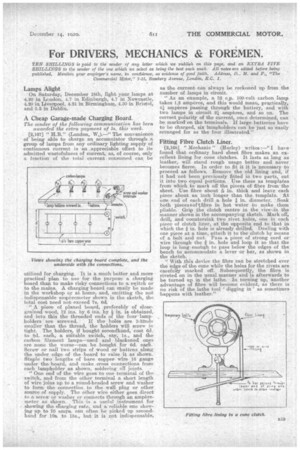For DRIVERS MECHANICS & FOREMEN.
Page 29

If you've noticed an error in this article please click here to report it so we can fix it.
TEN SHILLINGS is paid to the sender of any letter which we publish on this page, and an EXTRA FIVE SHILLINGS to the sender of the one which. we select as being the best each week. An notes are edited before being published, Mention your employer's name, in confidence, as eridence of good faith. Address, _D., M. and F., "The
Commercial Motor," 7-15, .Rosebery Avenue, London, E.C. 1. •
Lamps Alight.
On Saturday, December 18th, light your lamps at 4.20 in London, 4.7 in Edinburgh, 4.7 in Newcastle, 4.20 in, Liverpool, 4.21 in Birmingham, 4.30 in Bristol, and 5.5 in Dublin.
A Cheap Garage-made Charging Board.
The sender of the following communication has been awarded the extra payment of 5s. this week. [2,1671 " H.R." (London, W,).—" The convenience of being able to charge an accumulator through a group of lamps from any ordinary lighting supply of continuous current is an ,appreciable offset to its admitted wastefulness of current, as, of course, only a fraction. of the total current consumed can be utilized for charging. It is a midi bettor and more practical plan to use for the purpose a charging board than to make risky connections to a, switch or to the mains. A eharging•board can ensily be made in the workshop or at home, and, omitting the not ,indispensable ainpererneter shown in the sketch, the total cost need not exceed 7s. 6d.
"A pieces of planed board, preferably of closegrained wood, 12 ins. by 6 ins. by A in. is obtained, and into this the threaded ends of the four' lamp
holders are screwed. If the holes are 3-32ntis smaller than the thread, the holders will screw in tight. The holders, if bought secondhand, 'cost 6d. to $t1.. each, a suitable switch, say, 1s., and the carbon filament lamps—used and blackened ones are none the worse—can be bought for 6d. each. Screw or nail two strips of wood or battens along the under edge of the 'board to raise it as sliown. Staple. two lengths of bare copper wire 16 gauge under the board, and make cress connections from each lampholder as shown, soldering all joints.
"One end of the wire goes to one terminal of the switch, and from the other terminal a short length of wire joins up to a round-headed screw and washer to form the connection to the wall plug or other source of supply. The Other wire either goes direct. to a screw or washer or connects through an ampere
meter as shown. This is a. useful instrument for 'showing the charging rate, and a reliable one showing up to 10 amps, can often be picked up secondhand for 10s. to I5s., but it is not indispensable, as the cm-Tent can always be reckoned up from the number of lamps in circuit. • "As an example, a 32 c,p. 100-volt carbon lamp takes 1.2 anaperes, and this would mean, practically, 41 amperes passing through the battery, and with two lamps in circuit 2/ amperes, and so on. The correct polarity of the current, once determined, can be marked on the terminals. If large batteries have to be charged, six lampholders can be just so easily arranged for as the four illustrated.".
Fitting Fibre Clutch Liner.
[2,168] " Mechanic " (Uorley) writes:—"I have found that orclinary hard sheet fibre makes an excellent lining for cone clutches. • It lasts as long as leather, will stand rough usage better and never becomes fierce. In. order to fit it it is necessary to proceed as follows. Remove the old lining and, if it had not been previously fitted in two parts • out it into two equal portions. Use these as templates front which to mark off the pieces of fibre from-the sheet. Use fibre about in, thick and leave each piece about an inch longer than the template. At care end of each drill a hole in diameter. Soak both pieces&of ifibre in hot water to make them pliable. Grip the clutch centre in the vice in the manner shown in the accompanying sketch. Mark off, drill, and countersink two rivet holes, one in each piece of clutch liner, at the opposite end to that in which the f in. hole is already drilled. Dealing with one piece at a time, attach it to the clutch by means of a bolt and nut. Pass e, piece of strong cord or
through the in. hole and loop it so that the loop is long. enough to pass below the edges of the bench to accommodate a lever or bar, as shown in the sketch.
" With this device the fibre can be stretched over the edge of the cone while the holes for the rivets are carefully marked off. Subsequently, the fibre is riveted on in the usual manner and is afterwards to be turned up in the lathe. In turning tip, another advantage of fibre will become evident, as there is no risk of the lathe tool digging in' as sometimes happens with leather."






























